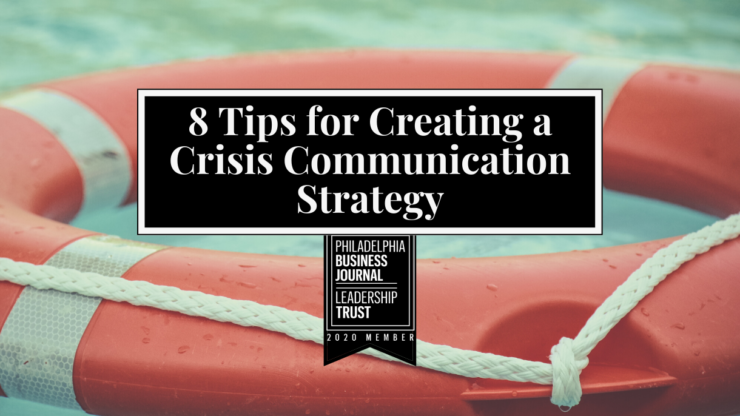All companies are susceptible to crises. In an era where news travels as fast as you can tweet it, every threat — both real and contrived — can inflict reputational damage if not managed properly. Whether it’s a natural disaster that impacts operations, a workplace incident, an angry ex-employee or a negative review, how and when you respond can make a world of difference.
Companies that don’t prepare tend to suffer the most. If you are trying to develop a plan while the building is on fire, it’s already too late. At that point, your CEO and communications teams are just doing their best to escape before the building collapses.
The key is to create a plan that acknowledges vulnerabilities before the crisis hits.
While it isn’t possible to plan for everything, a comprehensive crisis communications plan can preserve your organization’s reputation and credibility.
1. Plan ahead.
Schedule several brainstorming sessions with key executives and stakeholders to identify all potential threats to the company, both internally and externally. Start to map out possible responses and protocols. Make a list of all potential internal and external audiences that would be impacted by each threat. The immediate benefit may be that you realize that some situations are preventable by changing simple operational systems. In other instances, a much larger communications response is necessary. Knowing these ahead of time will help the team understand how to move forward.
2. Identify a crisis response team.
This is your go-to group of people in a crisis event. Ideally, this team will be led by the CEO and include the firm’s senior public relations counsel, senior management, finance, legal and representatives of the board. If your internal communications team is very junior, it may be worth hiring a third-party public relations agency or consultant with in-depth crisis communications experience.
3. Define roles for the team.
Once the team is in place, assign roles so everyone knows what to do when the pressure is on. As part of this process, make sure that you have identified those responsible for reaching out to all your target audiences including employees, stakeholders, funders and media. You will also need to determine the chain of command, along with “alternates” should the point person not be available.
4. Assign and train spokespersons.
When a crisis hits, your spokespersons will be the face and voice of the company, so be sure that they are credible, coherent and cool under pressure. As a general best practice, only approved spokespersons should speak to press even in the best of circumstances, but especially in a crisis. These people should be screened, vetted and media trained to ensure they are prepared to carry out their role successfully. It is important that they understand and can communicate the company’s position and key messages, especially if they are under fire.
Training and practice make a huge difference. Some CEOs are incredible in a room of people but freeze once a news camera starts rolling. Others may get flustered or agitated when a reporter asks tough questions. Professional training will help the organization identify the viability of certain spokespersons, while allowing them to build confidence in the skills they need to successfully navigate media interviews.
5. Identify your target audiences.
Every company has a variety of stakeholders, and each one will need customized messaging and outreach. Map out all the internal and external stakeholders that matter to your organization. Don’t forget your employees, who are your company’s most active and credible “spokespersons,” and also be sure to include current and potential customers.
6. Determine communication channels.
Remember when having a phone number was enough? Now you can call, text, email, IM, post, tweet, Skype and chat across any number of channels. Creating a notification system before a crisis hits is essential to ensure your message gets out quickly and efficiently. In many cases, you won’t determine which systems to use until a crisis occurs.
For example, if you are looking to downplay an issue, you may not want to preemptively blast it out across your company’s social media platforms. But if a catastrophe strikes, such as a food recall or public safety issue, you’ll want to have as many channels as possible at your disposal.
7. Monitor and adjust.
Establishing monitoring systems will help you “listen” to what is being said across platforms before, during and after a crisis. Active listening allows you to understand how conversations are trending and adjust your communications outreach accordingly. Pre-crisis monitoring allows you to hear and respond to potential issues before they become full-blown problems.
For traditional and social media monitoring, setting up Google Alerts for various keywords is free and easy. There are also a number of paid monitoring systems that can run more sophisticated reporting, including the tone of media coverage, keyword analysis, reach, and impact across social media platforms.
8. Create scenarios and holding statements.
In step one, we identified potential threats to the organization. Now we can start to build out the company response. While the full suite of messages will have to be developed after a crisis breaks, you can create canned general messaging and holding statements in advance, saving precious hours in response time. These scenarios and statements should be reviewed at least on an annual basis to ensure they remain relevant and accurate.
Post-crisis: Analyze and evolve.
After a crisis occurs, take the time to debrief. What went well? What didn’t? These lessons can inform the process and ensure you don’t repeat past mistakes. If you promised to make personnel or operational changes, make sure you follow through, and provide updates to stakeholders along the way.
Like insurance, crisis planning is something you need to have and hope you never need to use. If done well, your stakeholders will appreciate your company’s ability to navigate a tough situation. And your company will emerge a little stronger and better prepared to handle future issues.
Posted In Crisis Communications
 Rebecca Devine
Rebecca Devine 